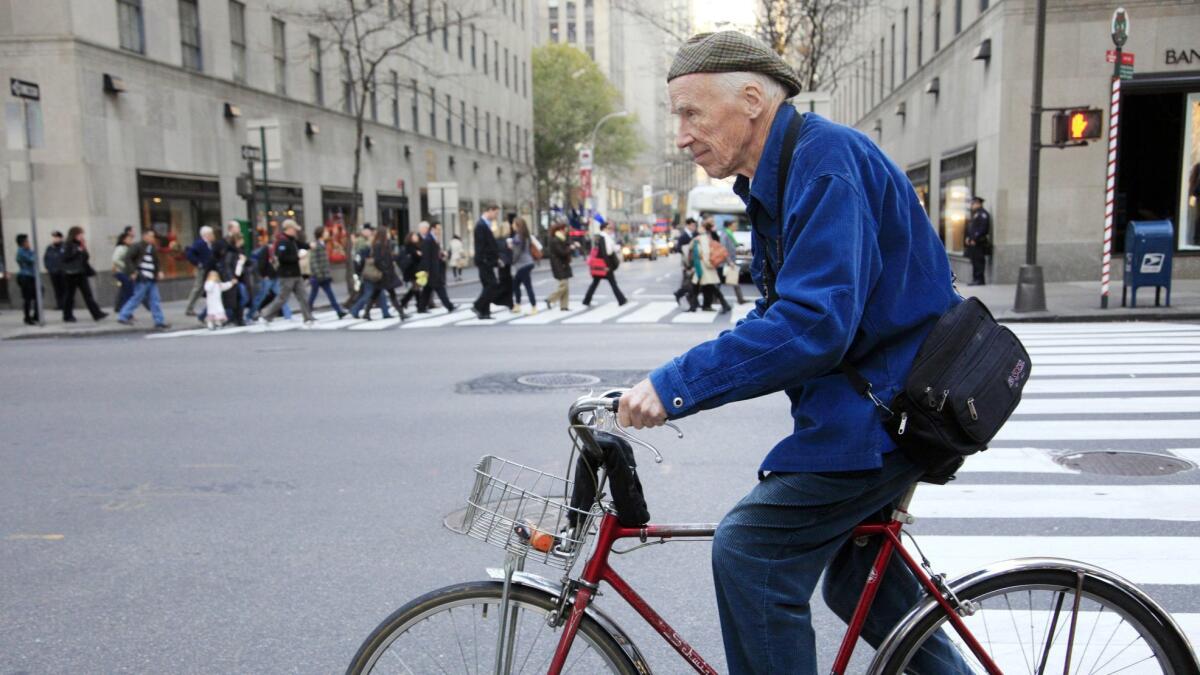A review of ‘Fashion Climbing’ by Bill Cunningham

- Share via
The practice and art of fashion, of getting dressed with a personal sense of style or an acceptance of trends, is a notoriously difficult one to take seriously on paper. It is philosophically frivolous. Fashion is undemocratic and classist. The pursuit of it is often phony or snobby or elitist, attention-seeking and social climbing. And yet, it is also one of the most important things we have to build and create our sense of self. Even the choice to have or not have fashion is a choice of selfhood. It is vital act.
No better case for its importance and significance has been articulated than by Bill Cunningham and his decades of work documenting the street style of New York City for the New York Times’ Sunday Styles section. In the fascinating and poignant documentary “Bill Cunningham: New York,” Anna Wintour offers magnanimous deference to the importance of Cunningham’s eye for documenting the whims and trends of everyday people as well as fashion denizens of the city, saying: “We all get dressed for Bill.”
In the same documentary, Cunningham shared his argument for fashion’s relevance: “Fashion is the armor to survive everyday life.” His fashion choices were practical — he famously wore a cheap cobalt blue French street cleaner’s jacket with khaki trousers, accessories his bicycle and camera. As he was one of the most observant and optically intelligent human beings of the 20th century, he understood that people could identify him in it. Even in the humblest, most affordable of uniforms, he stood out. It was simple and utilitarian, but not invisible.
What a surprise it will be for readers of his posthumous memoir “Fashion Climbing” to learn that he once spent his days planning and competing for prize money in costume competitions, creating lavish outfits for him and his so-called girlfriends.
Despite being a teetotaler, Cunningham was a pot-stirring rebel of New York City’s 1950s fashion scene as a hat maker, partygoer and party thrower, causing a ruckus every which way he turned in the name of creative expression.
“Fashion Climbing” begins with a brief but brutal description of childhood, being beaten by his mother for trying on girls’ clothes in their unsurprisingly uptight suburb of Boston. Cunningham makes clear that he didn’t make a choice for fashion. No. He exploded into the world as if a fragrant bouquet of flowers and frills had been shot out of a cannon. And he never looked back.
“Since childhood, an extra-sensitive sense has unlocked the door to my subconscious at least ten years in advance of everyone else. I’m able to feel and know what will be the general mood of fashion,” he wrote. “During my school days, family and friends were always laughing and calling my ideas in fashion ‘weird,’ but sure enough, within seven to ten years, the very people who condemned my thoughts would themselves be parading around in the clothes they had judged.”
For Cunningham, fashion was a religious vocation, which is appropriate, as he was a life-long churchgoer whose parents thought he might be a priest someday and were quite horrified by his life choices. To which Cunningham noted, “It’s a crime families don’t understand how their children are oriented, and point them along their natural way.”
“Fashion Climbing” is delightfully dishy, snarky, judgmental, harsh, kind, adoring and ridiculously straightforward. He describes party after party with quips such as, “The orgies that took place under the tables never bothered me, and I rarely ever saw them, as I was always up dancing and not just sitting and watching the wild goings-on.” (!!) He was an incomparable observer of the New York social scene, and it’s a true loss that he’s gone.
But the most wonderful part of “Fashion Climbing” for this reader wasn’t the divine and transformative writing about the clothes or the parties, it was reading about all of Cunningham’s personal heroes — all women. He had such respect and love for womankind and its intellect, curiosity, awareness, talent and, yes, beauty, that it is hard not to be gobsmacked reading it.
What a gift to learn about the whimsical art teacher who introduced him to Mrs. Jack Gardner and her Venetian palace on Boston’s Back Bay; of Gloria, the high school friend who was the “Brenda Star” of his life; Miss Ross, the stockist at Bonwit’s, and Miss Dawson the buyer, who gave him training that lasted his entire life; celebrity photographer Editta Sherman; and so many more.
Cunningham wrote that he wanted “to bring happiness to the world by making women an inspiration to themselves and everyone who saw them. I wanted fashion to be happy — but oh my God, what an idealist I was!”
“Fashion Climbing” is smart and pure, revealing of a person’s sense of truth, self, business, confidence and wonderment at the world. Cunningham’s happy exploration might feel frivolous to some, but on the contrary, it is tremendously important in fraught times that we remember we can devote ourselves to finding inspiration, pursuing dreams and chasing joy.
A.N. Devers is an arts journalist and editor. Her first book, “Train,” comes out next year from Bloomsbury. She is the founder of the Second Shelf, a rare book business and literary journal focusing on the writing of women.
“Fashion Climbing: A Memoir With Photographs”
Bill Cunningham
Penguin Press: 256 pp., $27
More to Read
Sign up for our Book Club newsletter
Get the latest news, events and more from the Los Angeles Times Book Club, and help us get L.A. reading and talking.
You may occasionally receive promotional content from the Los Angeles Times.








